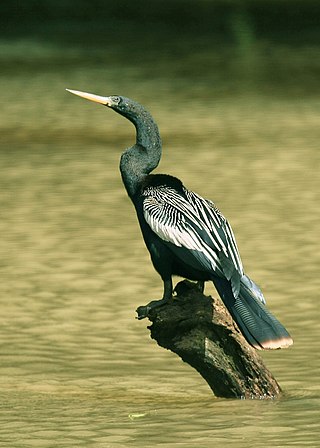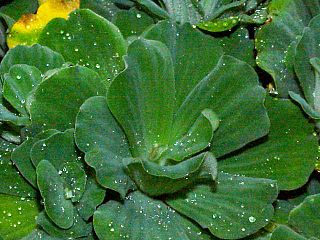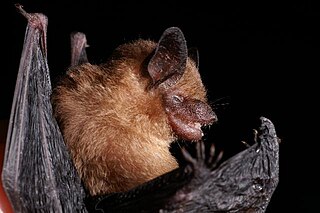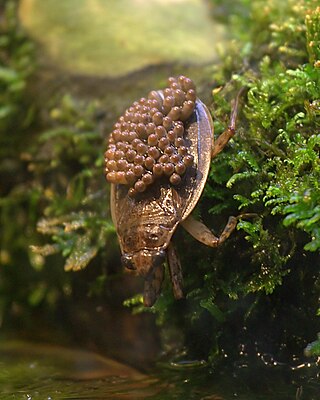
The southern platyfish, common platy, or moonfish is a species of freshwater fish in family Poeciliidae of order Cyprinodontiformes. A live-bearer, it is closely related to the green swordtail and can interbreed with it. It is native to an area of North and Central America stretching from Veracruz, Mexico, to northern Belize.

The anhinga, sometimes called snakebird, darter, American darter, or water turkey, is a water bird of the warmer parts of the Americas. The word anhinga comes from a'ñinga in the Brazilian Tupi language and means "devil bird" or "snake bird". The origin of the name is apparent when swimming: only the neck appears above water so the bird looks like a snake ready to strike. They do not have external nares (nostrils) and breathe solely through their epiglottis.

Pistia is a genus of aquatic plants in the arum family, Araceae. It is the sole genus in the tribe Pistieae which reflects its systematic isolation within the family. The single species it comprises, Pistia stratiotes, is often called water cabbage, water lettuce, Nile cabbage, or shellflower. Its native distribution is uncertain but is probably pantropical; it was first discovered from the Nile near Lake Victoria in Africa. It is now present, either naturally or through human introduction, in nearly all tropical and subtropical fresh waterways and is considered an invasive species as well as a mosquito breeding habitat. The genus name is derived from the Greek word πιστός (pistos), meaning "water," and refers to the aquatic nature of the plants. The specific epithet is also derived from a Greek word, στρατιώτης, meaning "soldier," which references the sword-shaped leaves of some plants in the Stratiotes genus.

The American crocodile is a species of crocodilian found in the Neotropics. It is the most widespread of the four extant species of crocodiles from the Americas, with populations present from South Florida and the coasts of Mexico to as far south as Peru and Venezuela.

The West Indian manatee, also known as the North American manatee, is a large, aquatic mammal native to warm coastal areas of the Caribbean, from the eastern US to northern Brazil. Living alone or in herds, it feeds on underwater plants and uses its whiskers to navigate. It is divided into two endangered subspecies, the Florida manatee in the US and the Antillean manatee in the Caribbean, both of which face pressure from habitat loss, pollution, and other human activity. The West Indian manatee is the largest of the sirenians, a group of large aquatic mammals that includes the dugong, other manatees, and the extinct Steller's sea cow.

Nepidae is a family of exclusively aquatic Heteropteran insects in the order Hemiptera. They are commonly called water scorpions for their superficial resemblance to scorpions, due to their raptorial forelegs and the presence of a long slender process at the posterior end of the abdomen, resembling a tail. There are 14 genera in the family, in two subfamilies, Nepinae and Ranatrinae. Members of the genus Ranatra, the most widespread and species-rich genus, are sometimes called needle bugs or water stick insects as they are slenderer than Nepa.

The Myrmecophagidae are a family of anteaters, the name being derived from the Ancient Greek words for 'ant' and 'eat'. Two genera and three species are in the family, consisting of the giant anteater, and the tamanduas. The fossil Eurotamandua from the Messel Pit in Germany may be an early anteater, but its status is currently debated.

Sternotherus is a genus of turtles in the family Kinosternidae including six species commonly known as musk turtles. The genus is endemic to North America, occurring in the eastern third of the USA and southeast Ontario, Canada. Musk glands positioned near the bridge of the shell can produce foul smelling secretions when the turtles are threatened, although gentle handling does not normally provoke a response. Sternotherus are moderately small turtles, with the largest species in the genus, the razor-backed musk turtle, attaining a maximum of 17.6 cm. in shell length. The carapace is characteristically oval and domed, with most species having one or three keels on the back which may become smoother and obscure with age in some species. Musk turtles are generally drab in color, mostly black, gray, brown, olive, or ocher, which aid in camouflaging them in their natural habitats. The head is relatively large and stout, marked with spots, streaks, or strips. The plastron has only 10 or 11 scutes, as opposed to 12, a more common condition in North American turtles. The tail is short, with males having a horny claw like tip.

Velvet water bugs are members of the family Hebridae. They are semiaquatic insects that live among moss or ponds with an abundance of vegetation, in which they prey on small arthropods. Velvet water bugs are the smallest of the Gerromorpha, and have an appearance of tiny veliids. Hebrids sometimes move across water surfaces, but walk or run rather than skate or scull on the surface.
There are a number of environmental issues in Florida. A large portion of Florida is a biologically diverse ecosystem, with large wetlands in the Everglades. Management of environmental issues related to the everglades and the larger coastal waters and wetlands have been important to the history of Florida and the development of multiple parts of the economy of Florida, including the influential agricultural industry. This biodiversity leaves much of Florida's ecological ecosystem vulnerable to invasive species and human sources of industrial pollution and waste.

Water treaders, the superfamily Mesovelioidea, are insects in the order Hemiptera, the true bugs. They are semiaquatic insects that live in moist and wet habitat and on wet plant matter in several types of aquatic habitat.

The Yucatan yellow bat is a species of bat found in the Yucatán Peninsula in Mexico, and possibly also in Belize and Guatemala. These small insectivorous bats forage on flying insects at dawn and dusk.

Abedus is a genus of giant water bugs found in freshwater habitats in southern United States, Mexico and Central America. Sometimes called ferocious water bugs, these brown insects typically are between 2.3 and 4 cm (0.9–1.6 in) long, although A. immaculatus only is about 1.3–1.4 cm (0.51–0.55 in), making it the smallest North American belostomatid and possibly worthy of separation in its own genus. Otherwise the different Abedus species are very similar and can often only be separated with a microscope. They will bite in self-defense, which is painful but not dangerous.

Cassytha filiformis or love-vine is an orangish, wiry, parasitic vine in the family Lauraceae. It is found in coastal forests of warm tropical regions worldwide including the Americas, Indomalaya, Australasia, Polynesia and tropical Africa.

Eretes sticticus, the western erete, is a species of predaceous diving beetle in the family Dytiscidae. It is found in Africa, the Middle East, and the Americas from the southern United States to Peru. This species preys specifically on mosquito larvae in ponds and pools. They can kill up to all the instar larvae of the mosquito depending on size and density of the prey.
Mesovelia amoena is a species of water treader in the family Mesoveliidae. It is found in the Caribbean Sea, Central America, North America, Oceania, and South America.

Mesovelia is a genus of water treaders in the family Mesoveliidae. There are more than 30 described species in Mesovelia.

Mesoveliidae is a family of water treaders in the order Hemiptera. There are about 16 genera and at least 50 described species in Mesoveliidae.
Belostoma testaceum is a species of giant water bug in the family Belostomatidae. It is found in the eastern United States from New York south to southern Florida and west to Texas and Michigan.

Belostoma minor is a species of giant water bug in the family Belostomatidae. It is found in the northern Caribbean bioregion, with records in Cuba, the Dominican Republic, Jamaica, Puerto Rico, U.S. Virgin Islands, and southern Florida in the continental United States.
















